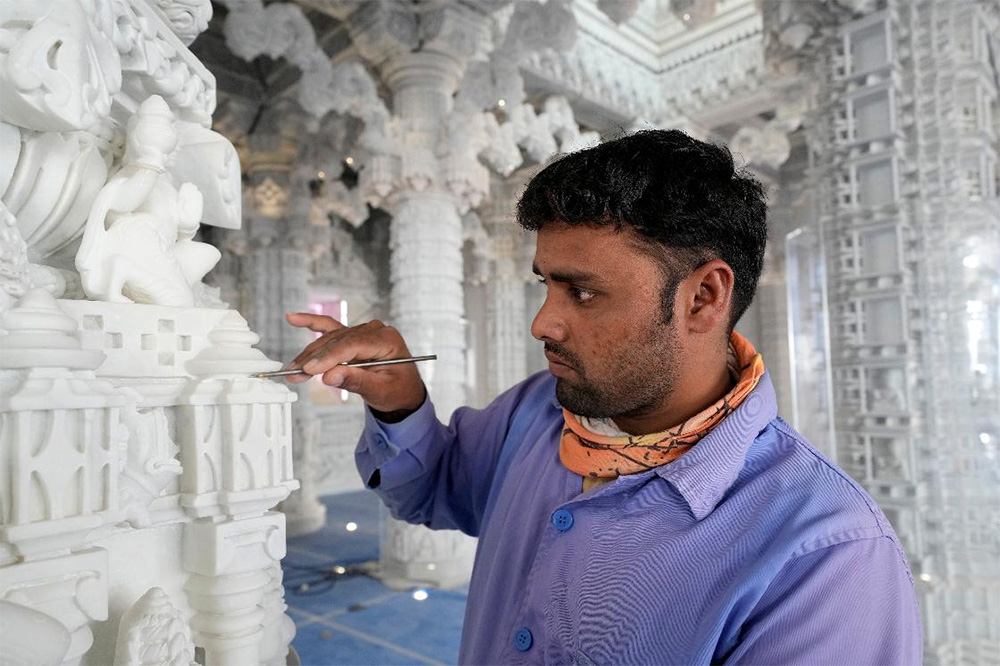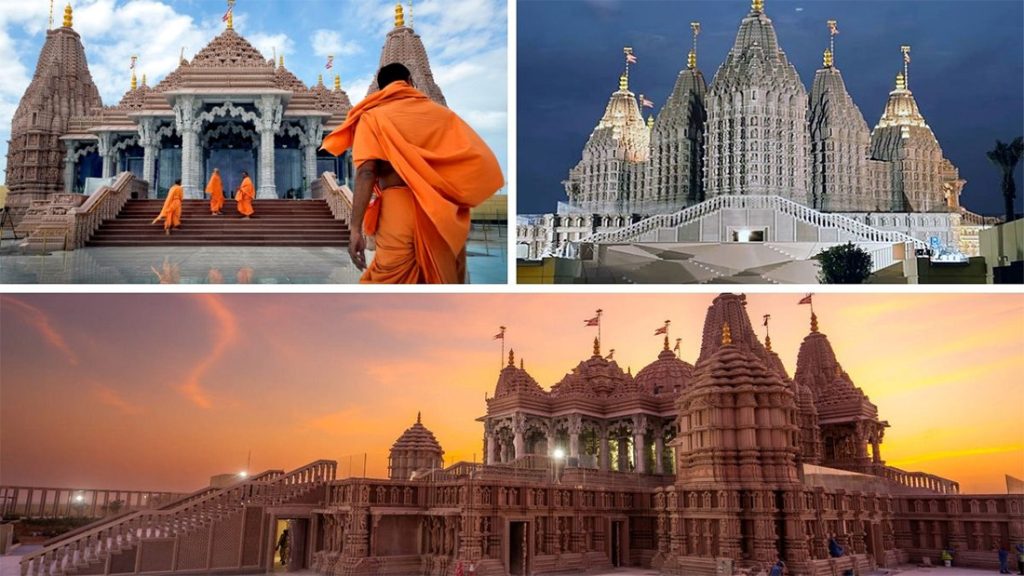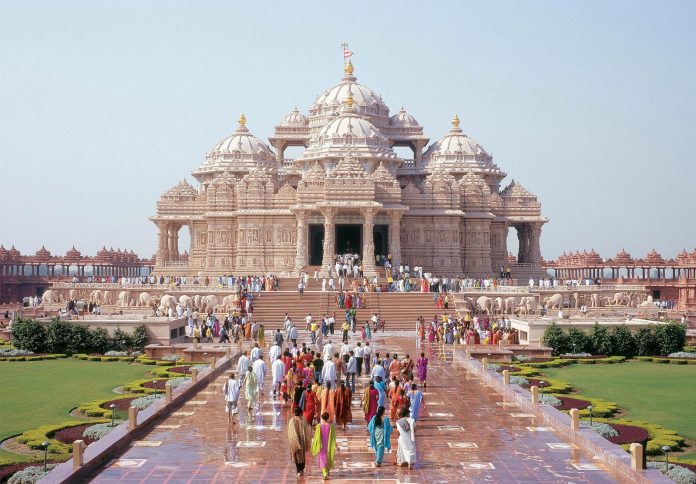Abu Dhabi: Constructed with eighteen lakh bricks, requiring seven lakh man hours and utilizing 1.8 lakh cubic meters of sandstone directly sourced from Rajasthan, Abu Dhabi’s inaugural Hindu temple adheres to the Nagara style of architecture, mirroring the recently unveiled Ram Temple in Ayodhya. Situated in the Abu Mreikhah Cultural District at an estimated cost of Rs 700 crore, this traditional stone Hindu temple is the Middle East’s pioneer in its category.
Set to be inaugurated by Prime Minister Narendra Modi on February 14, the UAE temple is part of the network of 1,200 temples overseen by the BAPS Swaminarayan Sanstha, an organization present in India and nations with a substantial Indian community such as the US, UK, Australia, and New Zealand.
In proximity, about 50 km away, stands the Sheikh Zayed Grand Mosque, the largest mosque in the country, welcoming a daily influx of 50,000 visitors, comprising both worshippers and tourists alike.

In an unprecedented display of goodwill in April 2019, preceding the foundation-stone laying ceremony of the temple, Sheikh Nahyan bin Mubarak, the Minister of Tolerance in the UAE, hosted Mahant Swami Maharaj, the spiritual leader of BAPS, and 50 other senior priests from India for a tour of the mosque. During the visit, the Mahant not only paid homage to the 99 names of Allah elegantly calligraphed on the mosque’s wall but also expressed admiration in the guest book, acknowledging the UAE government and its people for their dedication to fostering global harmony.
The 13.5-acre expanse on which the temple complex stands was generously gifted by Sheikh Mohammed Bin Zayed Al Nahyan, the President of the UAE, in 2019, according to a representative from BAPS. Rising to a height of 108 feet, the temple is equipped with 300 earthquake sensors, showcasing a commitment to both cultural and structural excellence.
Lina Barot, a volunteer and BAPS office-bearer, highlighted key architectural choices for the temple. She explained, “Given the warm climate of the UAE, we have incorporated nano tiles, ensuring comfort for visitors walking even in hot weather. Additionally, non-ferrous materials have been utilized in the construction of the temple.”
The traditional Nagara style of the temple aligns with the architectural heritage of Swaminarayan temples globally, reminiscent of structures like New Delhi’s Akshardham Temple. However, Lina Barot, a volunteer and BAPS office-bearer, notes that the Abu Dhabi temple incorporates several innovative elements specifically designed to “bring the two nations and cultures together.” This infusion of new elements reflects a harmonious blend of cultural traditions from both India and the UAE within the temple’s design.

The temple’s design includes seven shikhars (spires), symbolizing the unity of the seven Emirates forming the UAE. At the entrance, eight idols represent universal values like faith, charity, and compassion. The structure also incorporates depictions of landmarks from around the world, spanning East to West, and the Wall of Harmony features the word ‘harmony’ inscribed in 30 ancient and modern languages.
Emphasizing a fusion of materials, the external facade showcases pink sandstone sourced from Rajasthan, while the interiors boast Italian marble. Lina Barot shared with The Indian Express, “Interestingly, 20,000 tonnes of sandstone pieces were intricately carved in Rajasthan and then transported to Abu Dhabi in 700 containers.”
Furthermore, the labor force contributing to the temple’s construction over a five-year period includes many individuals from Gujarat and Rajasthan. Even the Italian marble, after being mined, was initially shipped to India for carving before making its way back to the UAE for use in the temple’s interiors. This intricate process reflects a global collaboration in the creation of this symbolic place of worship.
Sanjay Parikh, BAPS head of procurement and design, an experienced leader in overseeing the construction of over 40 temples worldwide, emphasizes an insightful approach: “The best thing, we have realized, is for the artists to work near their homes rather than on a temple site for years.” This approach not only ensures a more efficient workflow but also allows artists to work in familiar surroundings, potentially enhancing the quality and craftsmanship of their contributions to the temple.
The Abu Dhabi temple not only brings a small piece of India to the expansive desert landscape but also accommodates deities from various regions of the country, including Lord Ram, Lord Shiv, Lord Jagannath, Lord Krishna, Lord Swaminarayan (considered a reincarnation of Lord Krishna), Tirupati Balaji, and Lord Ayappa.
Given the unique challenge of constructing such a temple in a desert, engineering experts and consultants from around the world were enlisted for the project. Sia Keong Kong from the Malaysian firm SOE Consult Sdn Bhd, known for expertise in designing structures in regions with high seismic and wind design requirements, contributed to the temple’s realization. Additionally, Vasiahmed Behlim from UAE’s RSP Architects Planners and Engineers served as the lead structural engineer, with Shapoorji Pallonji overseeing project execution.
Beyond featuring 15 tales from Indian epics like the Ramayana and Mahabharata, the temple also incorporates narratives from Mayan, Aztec, Egyptian, Arabic, European, Chinese, and African civilizations. Surrounding the structure are artificially created rivers sourced from the waters of the Ganga and Yamuna, while the Saraswati is represented as a white light. The temple includes Varanasi-like ghats on one side, through which the artificial river flows. This intricate design showcases a fusion of diverse cultural and mythological elements in a harmonious architectural tapestry.
To ensure equal representation of the host country, the design of the Abu Dhabi temple incorporates not only animals that hold significance in Indian mythology, such as elephants, camels, and lions but also features the UAE’s national bird, the falcon.
The inclusive design reflects the shared values and spiritual ethos of both India and the UAE. At the foundation-stone laying ceremony, then-Indian Ambassador Navdeep Suri conveyed a message from Prime Minister Modi, stating, “When complete, this mandir will symbolize the universal human values and spiritual ethos that form a shared heritage of both India and UAE. The UAE is celebrating the Year of Tolerance. This Mandir is an expression by the UAE, of their love, friendship, and faith in India and the Indian community.” The temple, thus, becomes a testament to the strong bonds between the two nations, representing a celebration of shared values and a manifestation of tolerance and friendship.

